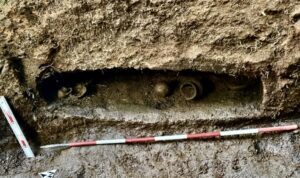
“La Biagiola” International School of Archaeology (B.I.S.A.), managed by the Associazione “Cultura e Territorio” (ACT), has once again showcased its unique approach to archaeological exploration, merging research, education, and preservation. After years of striving to become a leading reference in archaeology in the Maremma del Tufo, B.I.S.A. has now established itself as a true beacon for local institutions and communities, playing a pivotal role in safeguarding and promoting cultural heritage.
In 2015, B.I.S.A. students climbed the steep walls of the “Cavone” via cava (see below*) to recover and document the remnants of archaic Etruscan tombs and to safeguard these structures from the degradation caused by vegetation and soil accumulation. In 2016, they undertook the excavation and documentation of the lost dromos of the “Tomba dei Demoni Alati” (Tomb of the Winged Demons) in Sovana.
These initiatives complemented the ongoing investigations at “la Biagiola” and contributed to a broader landscape archaeology project in the Fiora River Valley:
__________________________
The 2024 Summer Campaign
During the summer of 2024, the school embarked on an ambitious program in collaboration with the Archaeological Park “Città del Tufo”, revisiting six Etruscan (see below**) tombs along the Via Cava di San Sebastiano. From August 1 to August 22, 2024, participants, including professional archaeologists, students, and local collaborators, worked tirelessly on-site. Their efforts were supported by personnel from the Municipality of Sorano and the ZOE Social Cooperative, concessionaires for the Archaeological Park, whom we would like to thank here warmly for their initiative and support.
These tombs, previously looted during Roman times and later subjected to sub-standard (by today’s professional assessment) excavations in the 19th and 20th centuries, offered unique challenges and opportunities for modern archaeology. This double history of disturbance left behind a trail of clues for modern archaeologists to uncover. Roman looters mainly targeted precious metals and jewelry, while 19th- and 20th-century excavators sought intact and elaborately decorated pottery. The earlier interventions often bypassed architectural features such as dromoi (entrance corridors) as excavators worked hastily, leaving behind crucial evidence for modern, meticulous archaeologists.
This summer’s work yielded significant results, including:
- Chronological Confirmation: ceramic fragments from the tombs confirmed their dating to the 7th–6th centuries BCE.
- Architectural Documentation: using advanced SLAM laser scanning, the team created detailed 3D maps of the tombs, highlighting variations in niche arrangements, funerary beds, and moisture control features.
- New Discoveries: a previously undocumented via cava near the tombs was identified, adding to the rich tapestry of the region’s landscape archaeology.
______________________________
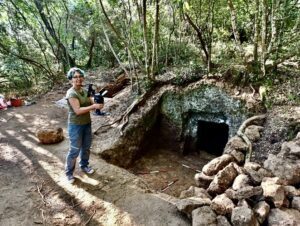
The survey using SLAM technology.
______________________________
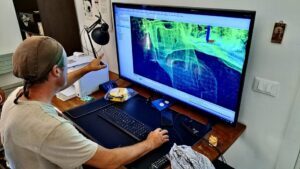
Workshop on 3D modeling.
______________________________
The Tombs
The tombs, located on a modest terrace northwest of the Via Cava di San Sebastiano, are arranged in two tiers (however, we also identified a row of four tombs at a lower level, which we have currently decided to leave buried for safety reasons):
- Upper Level: Tombs 1, 2, and 4.
- Lower Level: Tombs 3, 5, and 6.
Despite the absence of intact archaeological deposits in most structures, the team successfully identified secondary ceramic fragments meticulously recovered from the basal levels, providing invaluable data on the material culture of the Fiora and Albegna valleys.
The students also enjoyed distinguishing the layers of the first looting from the Roman era from those of the more recent one, caused by amateur archaeologists.
Highlights included:
- Tomb 2: distinguished by its architectural refinement, including a large rectangular niche opposite the entrance and stepped access.
- Tomb 3: unique evidence of reuse was observed, including an enlarged entrance and an extended dromos, with a drainage channel added at a later stage.
______________________________
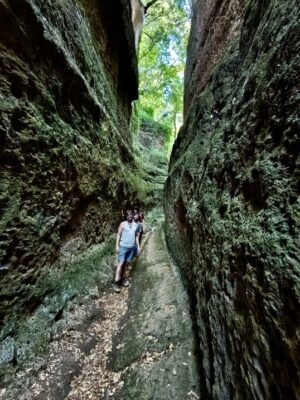
The Via Cava di San Sebastiano, one of the most evocative in the area.
______________________________
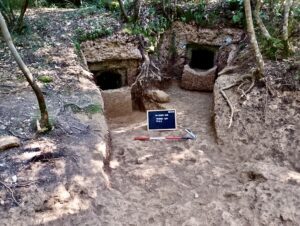
The entrance to the first two tombs after excavation: note the two intersecting dromoi and the two sealing stones broken at the top by Roman looters.
______________________________
Last but not least, anyone involved in archaeology knows it — the most important discoveries happen on the last day of excavation, preferably in the final hour, and even better under a looming thunderstorm:
- Tomb 5: this tomb revealed two primary-context features:
- A ritual pit containing a double-handled bowl and four varied dishes.
- A funerary niche sealed with terracotta tiles, containing nine ceramic vessels, spindle whorls, and a bronze fragment.
And here is the proof, beyond the wealth of scientific data recovered from the other tombs: the necropolises of Sovana always hold a surprise! What makes this discovery truly extraordinary is the presence of a votive pit, unexpectedly and exceptionally well-preserved through the centuries, lying just a few centimeters beneath the surface. This represents an exceptional testimony to the religious practices associated with funerary offerings.
______________________________
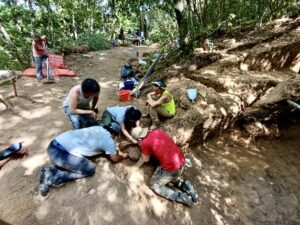
Excavating the ritual pit.
______________________________
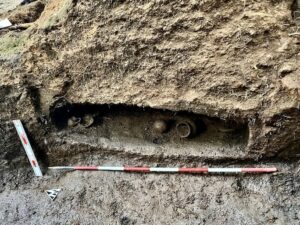
The funerary niche after the removal of the tiles.
______________________________
Bridging the Past and Future
The summer’s work at B.I.S.A. underscores its dual mission of education and research. Participants gained hands-on experience in advanced archaeological techniques, including 3D scanning and stratigraphic analysis, while contributing to a growing body of knowledge about the region’s history. The findings, including architectural surveys and ceramic typologies, will inform future studies and support the creation of a comprehensive catalog of archaic tombs in the Sovana area.
By aligning academic rigor with community engagement, B.I.S.A. continues to demonstrate that archaeology is not just about uncovering artifacts but about connecting people to their shared heritage: a bridge between the past and the future.
Readers may learn more about the programs and the archaeological field school here.
_____________________________
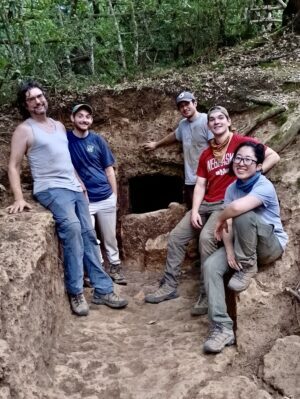
The student team: thank you all!
_____________________________
*The vie cave (hewn roads)
The hewn roads, carved into the volcanic tuff, were sophisticated pathways designed to connect the plateaus to nearby stream courses. These trenches often followed natural gullies, creating a more gradual and convenient approach to the steep elevation changes characteristic of the region. This intricate network not only linked major centers but also facilitated communication between smaller, scattered settlements. Along many of these routes, necropolises were established, taking advantage of the accessibility provided by the vie cave. However, not all such structures are directly associated with funerary sites, indicating a multifaceted use of these pathways.
Today, the vie cave are an evocative feature of the Maremma del Tufo landscape. Their continuous use over the centuries, for maintenance and because of natural erosion, has significantly deepened these trenches, with some reaching depths of dozens of meters. This contrasts sharply with their original appearance, which, as seen in abandoned vie cave, was far shallower.
The interplay between natural and human influences has transformed these ancient pathways into dramatic and captivating landmarks of the countryside.
**The Etruscans
The Etruscans were an ancient people who inhabited current day central Italy from around 900 BC to roughly 100 BC. They possessed a common language and culture but governed themselves independently through federations of city-states (three confederacies in all: Etruria (today’s Tuscany, Latium and Umbria), the Po Valley with the eastern Alps, and the area known today as Campania. At its greatest extent, Etruria covered what is now Tuscany, western Umbria, northern Lazio, the Po Valley, Emilia-Romagna, south-eastern Lombardy, southern Veneto, and western Campania.
As an indigenous population, they stemmed from the Iron Age Villanovan culture, which developed out of the late Bronze Age Proto-Villanovan culture, part of the central European Urnfield culture system. The Etruscans dominated the Italian peninsula until the rise of Rome in the late 4th century BC. By 27 BC, the Etruscan territory was incorporated into the Roman Empire.
In the Etruscan political system, authority resided in its individual city-states, ruled by prominent families. In the hey-day of their power, the elite Etruscan families became very wealthy through trade with the Celts to the north and the Greeks to the south. Evidence for this was uncovered through archaeological excavations that uncovered large family tombs with luxury objects imported from Greece and other contemporaneous civilizations.
The history of the Etruscan civilization is divided into distinct periods based on archaeological evidence and cultural developments:
Villanovan Period (ca. 900-700 BCE): this proto-Etruscan phase marks the emergence of a stratified society in central Italy. Evidence includes cremation burials in biconical urns and settlements characterized by small, hut-like structures.
Metallurgical advancements and the introduction of ironworking are key features of this era.
Orientalizing Period (ca. 700-580 BCE): marked by increased contact with the Greek, Phoenician, and Near Eastern cultures. This period saw the rise of urban centers such as Targuinia, Veii, and Cerveteri. Luxury goods, monumental tombs, and the widespread adoption of imported artistic motifs define this era, reflecting the growing wealth and complexity of Etruscan society.
Archaic and Classical Periods (ca. 580-300 BCE): the height of Etruscan power, with large-scale urbanization and the construction of monumental public works, including temples and city walls. Etruscan art and architecture show significant Greek influence, while their political institutions adapted to manage expanding trade networks.
Hellenistic Period (ca. 300-50 BCE): a phase that sees Roman expansion absorbing Etruscan cities. This period is characterized by a blend of Etruscan and Roman cultural elements, the adaptation of Etruscan religious practices, and the eventual assimilation into Roman hegemony.
_____________________________
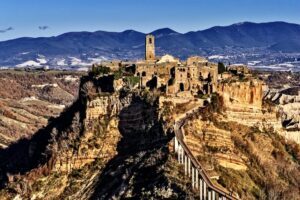
EXPLORE THE ANCIENT ETRUSCANS IN PERSON!
Experience a unique, up-close-and-personal hike among ancient hilltop towns in central Italy. You will walk the sensational countryside of the regions of Umbria and Tuscany, soaking in important sites attesting to the advanced Etruscan civilization, forerunners of the ancient Romans; imposing architectural and cultural remains of Medieval Italy; local food and drink; and perhaps best of all — spectacular scenic views! Join us in this collaborative event for the trip of a lifetime!


